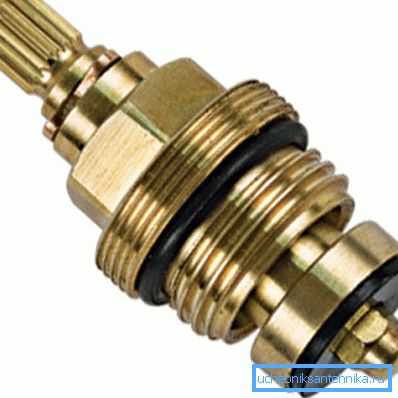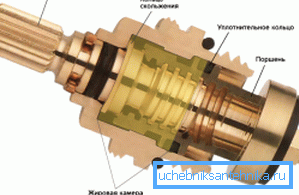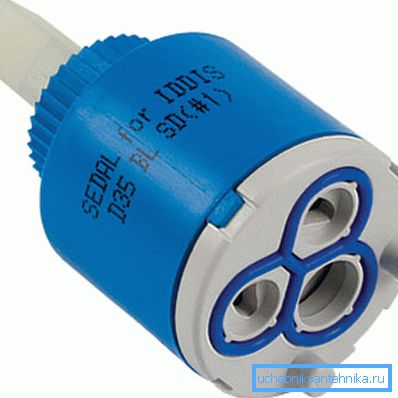Learning how to replace the crane
There are two types of faucets for kitchens and bathrooms, in which the stop valves are fundamentally different in their design. That is, in a ball mixer it is a steel ball with holes, or it may be an option with a cartridge, and for a valve device - a helical box with a rubber valve.
The first option is usually not repaired, although it rarely fails. But cartridges and axle boxes are to be replaced, which prolongs the life of the locking mechanisms.

We are, in this case, interested in replacing the axle box, which will be discussed below. And besides, your attention will be invited to the video in this article.
Buksa
What it is

In principle, any crane-box model will not differ from other variants of the model range - they all serve to block the flow of the water supply to the spout, or it can be a main stop valve. Whatever it was, but the flow in any case is blocked by a rubber valve, on which for the most part depends on the performance of this mechanism. (See also the article How to choose a sink faucet: features.)

In addition to the rubber gasket, the worm gear on the rod, which can apply pressure to the gasket properly, can directly affect the performance of the valves.
We mentioned this part of the mechanism not without reason, since even with not worn rubber, problems can arise - the thread is simply eaten up and it seems that the valve slips.
But a similar problem of overshooting can also occur with a certain wear of the gasket - it turns out that the thread completes its step, but at the same time there is no sufficient blockage. It is quite natural that you need to make a few more rotations of the rod, but the length of the worm has already been expended, therefore, it turns out such a jump, which can even be felt with a hand on the lamb in the form of a blow.
Note. Please note that a real valve may have a retaining ring. In case of dismantling, it should be removed with uki (the instruction recommends doing it that way) or even with old scissors.
Replacement

- First you need to make sure which type of crane you are dealing with. - if this is a model with one lever, then there can be no talk about the presence of the axle box in the mechanism - there, either a metal ball with holes or a plastic cartridge is installed as a shut-off valve.
- In addition, if there are valves on the mixer, then the presence of an axle box there can tell the number of revolutions of the lamb around its axis - if it is a so-called semi-fast valve, then there is a ball stop valve. The fact that you can make 5-6, or even 10 revolutions of a lamb around its axis can tell you about the presence of an axle box.

- Now, let's understand how to replace the crane box in the mixer with your own hands. First of all, you have to unscrew the lamb, which regulates the water pressure in one or another part of the crane and for this most often you need a regular screwdriver with a minus-type tip, although this may be cruciform (shaped) fittings.
- In order to unscrew the butterfly (valve) on the mixer, it must be held, that is, the bolt is unscrewed counterclockwise, and the crosspiece itself is held by hand (with flat / pliers it is impossible - damage the lining).
Attention! When carrying out this procedure, be careful - the screwdriver slides off into your palm very easily! With careless dismantling, you can simply pierce your hand!
- So, when you removed the wing, pay attention to whether there is a lock ring or lock nut in the bush., and maybe these two fuses are installed there simultaneously (it makes no difference in the design). Before starting work, do not forget to turn off the main valve. Which should be at your water meter (if any). To begin with, try to unscrew the knot by hooking it with a pliers or a key to the rod - it must be twisted counterclockwise.
- Be careful - if you can’t scroll through the square of the stem, it means there is some kind of fuse in the form of a lock nut or retaining ring - you will have to remove them. Here it is most convenient to use a wrench (even better - a cap, the right size), but you may have to insure the axle box so that it does not turn (this is done with another key or with pliers).

- When you remove all possible fuses (lock nut, retaining ring), you can now twist the bush and the rotation of the rod must be carried out counterclockwise.
- Now, attention - it is not always necessary to change the entire node., Sometimes it is enough to deploy a rubber gasket and it will serve you for a few more months! Rubber can simply be pressed on one side and, having turned it on its back side, you will receive high-quality valves.
- In addition, if you do not have the opportunity to replace the crane-box with a new one, then it is possible to replace the rubber gasket. To do this, you can use an old tire, more precisely, a spike, in which there is no thread (wire) cord. In this case, you only need to carefully cut out the shape (circle) of the rubber plug so that it fits into the seat of the guide washer.
- Do not neglect the cleanliness of the site. - when you unscrew the bush, you can open the main tap for water supply for 1-2 seconds - this will allow you to jet out all the trace elements that can remain on the thread. The use of fum-tapes, as well as Unipack-type lubricants is not provided here - sealing is achieved through gaskets!

- To install a new bush, you need to provide a sample of the old node in the store. - otherwise, you can simply take the wrong part (which is right for you). When you bring this element home, do not rush to tighten it with keys - by tightening the threaded connection of the pipes with your hands, you can check it for leakage. That is, screw the bush into the mixer housing, squeeze the locknut or install the retaining ring, and then open the main water supply valve.
- Do not rush to clamp the threaded connection key - first you need to check it for leakage, and it is best to make it toilet paper. After you open the water supply to this node, wait one or two minutes and attach the paper to the joint - you will see a wet mark at the slightest leakage of the joint. If this happens, hold the knot a little tighter.
Conclusion
We can immediately say that the price of the crane-box is too democratic to neglect their replacement in case of wear. Therefore, its repair (replacement of component parts) is permissible only in extreme cases - that is, when it is not possible to purchase a new node.